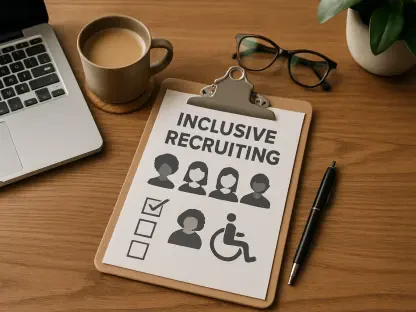Sofia Khaira, a renowned expert in diversity, equity, and inclusion, challenges traditional paradigms in HR by advocating for a skills-first approach in the rapidly evolving landscape of artificial intelligence. Her insight into talent management pushes companies to rethink hiring strategies and focus on fostering inclusive workplaces that drive innovation and engagement.
How has AI reshaped the way we work and learn in recent years?
AI has dramatically transformed both work and learning, evolving how we perform tasks and acquire knowledge. It’s automating repetitive tasks but also creating pathways for personalized, skill-based learning. This shift demands that companies rethink their talent strategies to keep pace with technology’s advancement, prioritizing adaptability and continuous skill development over static processes.
Why can’t companies rely solely on hiring to address the growing skills gap?
Relying exclusively on hiring overlooks crucial development opportunities within the current workforce and fails to address the root of the skills gap. It’s a reactive approach that tends to focus narrowly on immediate role needs rather than preparing employees for future challenges. By investing in skill-building and internal mobility, companies tap into a broader spectrum of talent and foster loyalty and engagement.
What are the fundamental flaws of traditional hiring methods that are revealed by AI?
Traditional hiring places undue emphasis on credentials and experience, which AI has shown does not necessarily equate to capability. This method is inherently reactive, aiming to fill positions without considering the rapidly evolving skill requirements. AI highlights the need for focusing on transferable skills, such as critical thinking and adaptability, which are crucial in navigating technological disruption.
How is AI affecting the need for advanced skills in the workplace?
AI is intensifying the demand for advanced skills by automating routine tasks, thereby shifting the workforce’s focus toward more complex, cognitive functions. This evolution requires employees to continuously update their skillsets to remain competitive and valuable, emphasizing the importance of adaptability and learning agility.
Why do traditional job descriptions fall short in today’s work environment?
Traditional job descriptions often fail to capture the dynamic, skills-first nature of today’s workplace needs. They tend to be rigid and role-specific, lacking the flexibility to evolve with technological advancements and industry changes. Instead, a skills taxonomy helps map necessary competencies, supporting internal mobility and agility in adapting to new roles and requirements.
What are transferable skills, and why are they becoming more valuable?
Transferable skills, such as adaptability, collaboration, and critical thinking, are increasingly vital as they equip employees to navigate diverse tasks and challenges. In a world driven by continuous change, these skills enable workers to pivot across roles and industries, helping organizations remain agile and competitive.
How can HR leaders facilitate the shift from degree-based hiring to a skills-first approach?
HR leaders can drive this shift by implementing skills taxonomies and fostering a culture of continuous learning. By aligning talent strategies with skill requirements rather than formal education, they open pathways for internal talent mobility and targeted development opportunities, aligning more closely with evolving business needs.
What evidence supports the effectiveness of skills-focused learning in organizations?
Research from platforms like Udemy shows that skills-focused learning directly impacts productivity and retention. Organizations adopting this approach report improved employee engagement and better business outcomes, underscoring the direct benefits of a skills-centric talent strategy.
What elements are crucial for developing a skills-first talent strategy?
Key elements include creating clear skill maps, encouraging continuous learning, and facilitating internal mobility. This involves replacing static job descriptions with dynamic skills taxonomies, developing reskilling programs, and integrating learning into everyday work practices.
How does continuous learning differ from traditional, one-time training initiatives?
Continuous learning embeds skill development into daily workflows, enabling employees to adapt and evolve constantly. Unlike traditional training, which is typically periodic, continuous learning emphasizes ongoing progression and flexibility, promoting sustained engagement and competence.
In what ways can AI help close the skills gap?
AI can narrow the skills gap by providing personalized learning experiences, identifying skill deficiencies, and suggesting targeted development paths. It removes guesswork and accelerates skill acquisition, effectively preparing employees for evolving roles and industry shifts.
How do AI-powered platforms personalize learning experiences for employees?
AI platforms tailor learning by assessing employee skill levels and crafting individualized training plans. They adjust content and delivery based on real-time progress, ensuring relevant and engaging experiences that maximize learning efficacy.
What are some common barriers to upskilling, and how can AI help overcome them?
Barriers include resistance to change and lack of motivation. AI addresses these through interactive, personalized learning experiences that enhance engagement and foster trust, making skill development more approachable and relevant.
How can AI assist HR leaders in forecasting future skills needs?
AI helps HR leaders by analyzing industry trends and data, enabling predictive insights into future skill requirements. These forecasts allow organizations to proactively adjust talent strategies and training programs to remain ahead in a competitive landscape.
What concerns exist around AI’s accuracy and trustworthiness in the workplace?
Concerns primarily revolve around data handling and decision-making transparency. Employees fear biases or errors impacting their roles. Clear communication and ethical design must be prioritized to build trust and acceptance of AI-driven transformation.
How should HR leaders address employee concerns about AI affecting their roles?
HR leaders should emphasize AI’s role as a partner in career enhancement, not a replacement. Transparent communication about AI benefits, cooperative opportunities, and augmented decision-making can alleviate fears and encourage more positive engagement.
What role should ethical design and transparency play in developing AI tools for HR?
Ethical design ensures fairness, privacy, and unbiased outcomes, while transparency fosters trust and acceptance. Both are essential in creating AI solutions that respect employee rights and empower rather than undermine human potential.
How can AI be used to promote collaboration rather than hinder it?
AI can enhance collaboration by streamlining communication and automating administrative tasks, freeing up time for meaningful interaction. It can facilitate shared learning and information exchange, supporting collective efforts and team synergy.
Why is it essential for HR leaders to view AI as an enabler rather than a disruptor?
AI represents a transformative opportunity to redefine talent strategies and optimize workforce potential. Viewing it as an enabler emphasizes its positive impact on efficiency and skill development, driving innovation and resilience in the organization.
What steps can HR leaders take to put upskilling with AI at the center of their talent strategy?
HR leaders can begin by integrating AI-driven analytics to assess skill gaps and forecast future needs. Prioritizing personalized learning solutions, promoting continuous development, and redefining job roles through skills taxonomies will embed upskilling as a strategic advantage.









